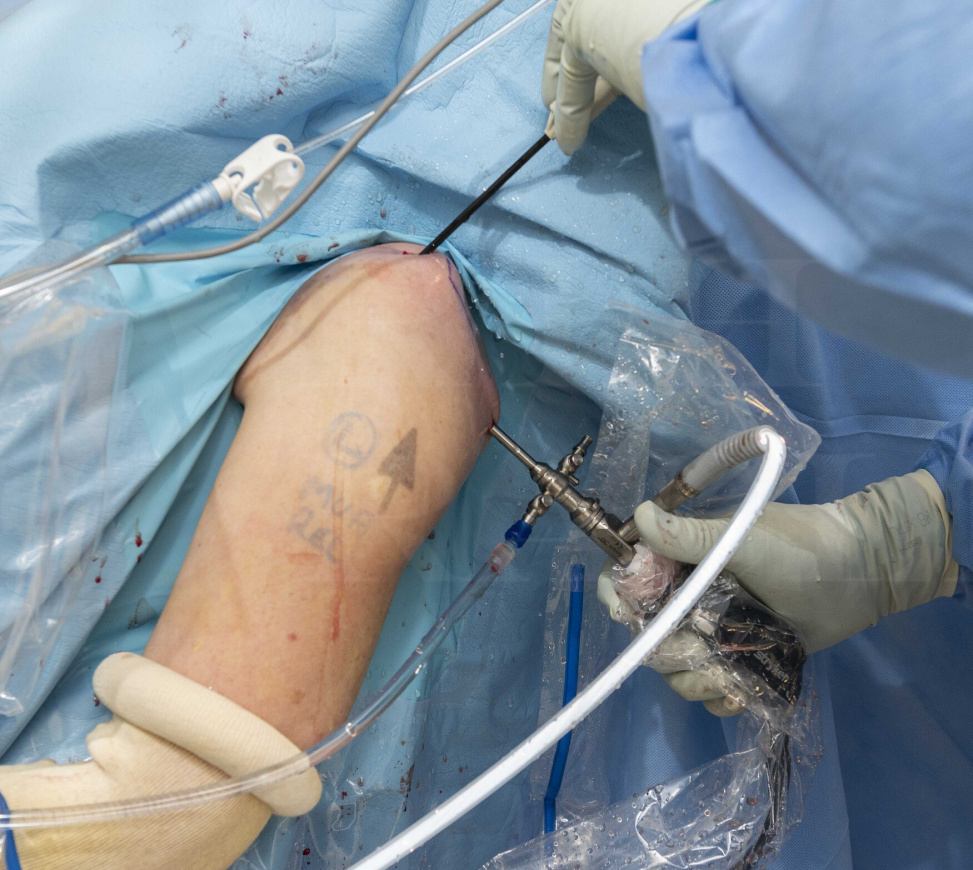Shoulder arthroscopy: Arthroscopic capsular release and MUA
Overview

Subscribe to get full access to this operation and the extensive Shoulder & Elbow Surgery Atlas.
Learn the Shoulder arthroscopy: Arthroscopic capsular release and MUA surgical technique with step by step instructions on OrthOracle. Our e-learning platform contains high resolution images and a certified CME of the Shoulder arthroscopy: Arthroscopic capsular release and MUA surgical procedure.
Stiffness in the shoulder is a problem that can arise due to glenohumeral arthritis, following trauma, or spontaneously; the latter is commonly called a frozen shoulder, although in practice, this term is widely and inappropriately used to cover patients presenting with a painful shoulder with a restricted range of motion, irrespective of the cause. The difference is of more than semantic difference as the natural history of a painful, stiff shoulder will differ considerably depending on the underlying cause.
Post-traumatic stiffness will usually arise following a clear and significant episode of trauma, such as a fracture, a dislocation or a traumatic tear of a tendon. While commonly the pain will settle with the natural healing of the underlying injury, and the range of motion will improve, predicting the outcome in terms of motion improvement is unpredictable in my experience, and persisting stiffness may warrant consideration of surgical treatments, including capsular release. (I consider post-surgical stiffness to be a subset of post-traumatic stiffness, as the index operation is after all a controlled form of trauma.)
Stiffness due to arthritis will usually come on slowly and progressively over years. When there is relative preservation of the joint surface, particularly in younger patients or those with little resting pain but activity-related functional restrictions due to stiffness and pain, synovectomy and capsular release may be indicated.
Frozen shoulder is the most common indication for consideration of a capsular release. This condition comes on spontaneously (although is more common in diabetics), but patients will often recall a precipitant event or episode; the natural history of frozen shoulder is to resolve, initially through a painful phase, then a stiffening phase, then a resolving (or thawing) phase, it is important to determine if the patient in front of you has a true frozen shoulder or had a significant traumatic precipitant, as the natural history will be different. Fortunately, the histories are usually characteristic!
Capsular release surgery, coupled with joint manipulation, will usually improve the range of motion that a patient has. Coupled with a synovectomy, which will often improve resting pain, the capsular release will help with the range and comfort of motion, so improving function, and the results of treatment can be very gratifying for both patients and their clinicians; the recovery process is, however, important as the shoulder will need to be moved to retain as much of the range improvement given by the release as possible. With care, the risk of procedure-specific complications, such as fracture or brachial plexus injury, is very low- in the order of 1:1000.
My personal preference is to undertake a controlled manipulation under anaesthetic to free the capsule and improve motion, with a low threshold to stop and move onto the arthroscopic steps of the surgery; in this way, the risk of causing structural damage to the shoulder (fractures, labral tears, cuff damage) is minimised as the arthroscopic capsule division will create a weak spot, allowing subsequent re-manipulation to propagate the capsular defect into the areas where the tendon blends with the capsule, or surgical release would carry a greater risk of damaging adjacent structures, such as the axillary nerve at the inferior aspect of the joint.
Patients with painful, stiff shoulders secondary to a frozen shoulder will usually see an improvement in their condition with time, although the progress may be slow; as the long-term outcome is likely to be similar irrespective of the treatments adopted in the painful and stiffening phases, treatment options at presentation can be determined by the patient’s requirements in the short to medium term (pain control; motion improvement vs functional adaptations while the natural history unfolds)- the majority of patients will not initially choose a capsular release procedure in my experience, although this is a very reasonable option to discuss with them. Other patients whose shoulder pain and stiffness is due to early glenohumeral arthritis, or post-traumatic stiffness, where the medium to long-term outcome is of an expected deterioration (with OA) or of a less predictable long-term improvement with post-traumatic stiffness, surgical treatment at initial presentation has a clearer role.
OrthOracle readers will also find the following instructional techniques of interest:
Shoulder arthroscopy: Arthroscopic rotator cuff repair with Arthrex Speedbridge
Shoulder arthroscopy: Arthroscopic anterior labral repair stabilisation (Arthrex 2.9 Biopushlocks)
Shoulder arthroscopy: Arthroscopic subscapularis tendon repair utilising Smith and Nephew Healicoils
Total shoulder replacement: Lima SMR stemless reverse shoulder
Total shoulder replacement: Lima stemmed SMR reverse geometry replacement (nickel free implants)
Author: Chris Little FRCS(Tr & ORTH)
Institution: The Nuffield Orthopaedic centre, Oxford, UK.
Clinicians should seek clarification on whether any implant demonstrated is licensed for use in their own country.
In the USA contact: fda.gov
In the UK contact: gov.uk
In the EU contact: ema.europa.eu
Online learning is only available to subscribers.



















